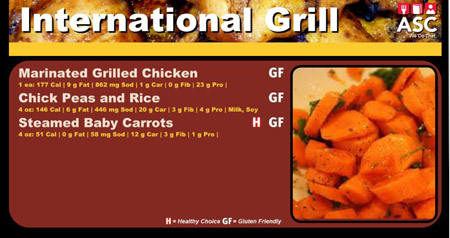Bulletin News

01/21/2014
The College’s Dining Services has listened to students’ requests and followed national trends by posting real-time nutrition and allergen information on its website and digital signage at campus eateries.
The information is “in your face,” just as students had requested.
Nutritional information on the digital signs and website includes: serving size, calories per serving, fat, sodium, carbohydrates, fiber and protein. Identified allergens include eggs, milk, soy and gluten. Symbols on the digital signs alert students to healthy food choices and gluten-friendly products.
The symbol for a healthy food choice is a white “H” with a red circle behind it.
 |
| Across campus, Dining Services has added nutritional information such as gluten free and healthy options to the digital menus on display in the food service areas. |
Dining Services rolled out the nutrition and allergen program in August 2013 on its website and in Neubig Dining, the residential facility. It plans to bring the program to the retail facilities — all dining facilities except for Neubig — as the semester opens. A new residential facility, The Bistro, to be located inside the new Student Life Center currently under construction, will feature the enhancements in January 2015.
Dining Services, a unit of the SUNY Cortland Auxiliary Services Corporation, began work on the program when both the 2011 and 2012 National Association of College and University Food Services (NACUFS) surveys showed nutritional content and variety of healthy menu choices increasing in importance to students.
“Dining Services offers a large variety of healthy foods,” says Bill McNamara, director of dining services. “But we do find that what students define and choose as healthy and what is actually healthy is not necessarily the same thing.”
As delighted as most were at seeing the nutritional information available on the digital signs, for some it turned to shock as they didn’t know how unhealthy their choices were, says McNamara.
“Having the nutritional and allergen information on the digital signs and on the website is not only helping to educate students and keep them safe from an allergic reaction, but it’s helping us create more nutritional menus,” he said.
Andrea Hart, ASC’s registered nutritionist and dietician, spells out what is necessary for a food item to qualify as a healthy choice.
“A serving must contain less than or equal to 15 percent of the daily value for calories, total fat, saturated fat and sodium and greater than or equal to 10 percent of the daily value for at least one of the following: dietary fiber, protein, vitamin A, vitamin C, calcium and iron,” Hart said.
The symbol for gluten-friendly products is a white “GF.” Following a recent FDA ruling on what it means for labeling a food product as “gluten-free,” Dining Services renamed Neubig Dining’s Gluten Free Zone to Gluten Friendly Zone. While inputs of food products do not contain gluten, they are processed in a kitchen that is not gluten free and cannot use the title of gluten free.
The Gluten Friendly Zone helps students with celiac disease and gluten sensitivity make better food choices by stocking gluten-friendly foods (GF) such as cereal, bread, cookies, pasta, entrees, crackers and other products. A cupboard, refrigerator, toaster, and microwave are provided for the sole use of GF diners. Retail dining units also provide gluten-friendly foods.
“This is very novel on campus,” McNamara said. “Most campuses don’t post nutrition information and in retail restaurants they aren’t posting this information up with the food.”
But that appears to be changing. SUNY Cortland’s effort appears to go further than that of other campuses, but more and more colleges are recognizing the importance of educating students about their food choices.
“It appears to be a trend now,” said Shannon Richard, executive director of campus operations at SUNY Morrisville’s auxiliary corporation and outgoing president of the SUNY Auxiliary Services Association. “Ours is listed online and is attached to each of our menu items online” but not posted on the menu message boards.
The University at Buffalo currently features nutritional information on the website along with allergen information at the point of sale, according to Raymond Kohl, marketing director for UB Campus Dining and Shops.
Oneonta posts detailed menus online and on the digital signs in each dining site, and is currently upgrading the website with further improvements, according to Nikki S. Brown, who represents the campus food service operator, Sodexo, as marketing coordinator and district safety coordinator.
Cornell University hasn’t made the change yet, although the information is very important to the campus community, according to Michele Lefebvre, Cornell Dining’s director of nutrition management.

